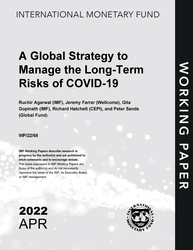
A Global Strategy to Manage the Long-Term Risks of COVID-19
A Global Strategy to Manage the Long-Term Risks of COVID-19
READ MORE...
Volume/Issue:
Volume 2022
Issue 068
Publication date: April 2022
ISBN: 9798400207990
$0.00
Add to Cart by clicking price of the language and format you'd like to purchase
Available Languages and Formats
| English |
Topics covered in this book
This title contains information about the following subjects.
Click on a subject if you would like to see other titles with the same subjects.
Economics- Macroeconomics , Economics / General , Health Policy , Demography , COVID-19 , pandemics , systemic risks , economic crisis , toolkit approach , policy implication , pandemic financing , omicron scenario , risks of COVID-19 , COVID-19 , Communicable diseases , Health care , Global
Summary
The pandemic is not over, and the health and economic losses continue to grow. It is now evident that COVID-19 will be with us for the long term, and there are very different scenarios for how it could evolve, from a mild endemic scenario to a dangerous variant scenario. This realization calls for a new strategy that manages both the uncertainty and the long-term risks of COVID-19. There are four key policy implications of such as strategy. First, we need to achieve equitable access beyond vaccines to encompass a comprehensive toolkit. Second, we must monitor the evolving virus and dynamically upgrade the toolkit. Third, we must transition from the acute response to a sustainable strategy toward COVID-19, balanced and integrated with other health and social priorities. Fourth, we need a unified risk-mitigation approach to future infectious disease threats beyond COVID-19. Infectious diseases with pandemic potential are a threat to global economic and health security. The international community should recognize that its pandemic financing addresses a systemic risk to the global economy, not just the development need of a particular country. Accordingly, it should allocate additional funding to fight pandemics and strengthen health systems both domestically and overseas. This will require about $15 billion in grants this year and $10 billion annually after that.
Copyright © 2010 - 2025
Powered by:
AIDC



